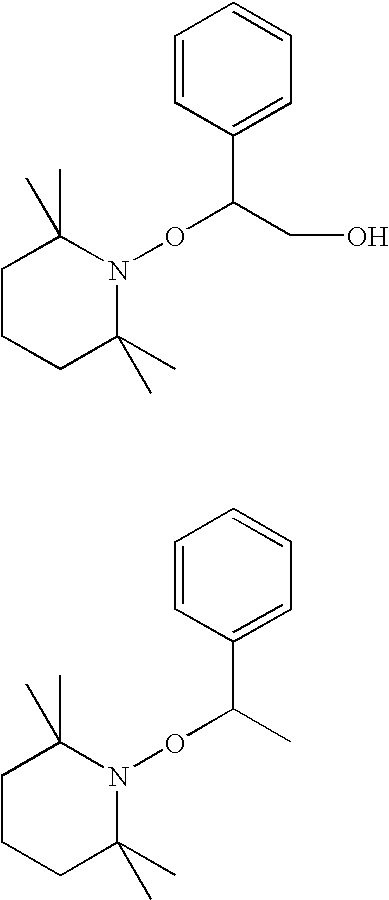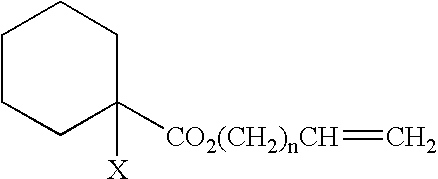Curing composition
a composition and composition technology, applied in the field of curable compositions, can solve the problems of insufficient weather resistance, difficult to employ on glass use, and difficulty in achieving the effect of good rubber physical property, superior weather or heat resistance, and low stress
- Summary
- Abstract
- Description
- Claims
- Application Information
AI Technical Summary
Benefits of technology
Problems solved by technology
Method used
Image
Examples
synthesis example 1
[0353] Each of the following vinyl polymers having a silyl group at the terminal was obtained according to the method described in Production Example 4 of Japanese Patent Laid-Open No. 2001-279108.
[0354] A vinyl polymer having an alkenyl group at the terminal (polymer [P1]) was obtained using CuBr (251.82 g, 1.76 mol), acetonitrile (3360 mL), n-butyl acrylate (33.60 L), diethyl 2,5-dibromoadipate (351 g, 0.975 mol), triamine (248.0 mL, 1.405 mmol), 1,7-octadiene (8640 mL, 58.5 mol), potassium acetate (245 g), N,N-dimethylacetamide (30 L), hydrotalcite (4.5 kg, KYOWAAD 500SH, KYOWAAD 700SL available from KYOWA CHEMICAL INDUSTRY CO., LTD.), and xylene (6.0 L).
[0355] A poly(n-butyl acrylate) polymer having a silyl group at the terminal [P2] was obtained using the above polymer [P1] (1000 g), dimethoxy methyl hydrosilane (53.7 mL), methyl orthoformate (15.9 mL), and a platinum catalyst. The polymer obtained had a number average molecular weight of about 29000, and the average number o...
synthesis example 2
[0356] A polymer having an alkenyl group at the terminal {a vinyl polymer of polybutyl acrylate having alkenyl at the terminal [P3] was obtained as above using CuBr (1.09 kg), butyl acrylate (130 kg), diethyl 2,5-dibromoadipate (2.28 kg), acetonitrile (57.1 kg), 1,7-octadiene (14.0 kg), and triamine (659 g).
[0357] A vinyl polymer having a silyl group at the terminal (polymer [P4]) was obtained using as raw materials the above polymer [P3] (54.9 kg), dimethoxy methyl hydrosilane (1.0 kg), methyl orthoformate (0.42 kg), and a 1,1,3,3-tetramethyl-1,3-divinyl disiloxane complex of zero-valent platinum in xylene. The polymer obtained had a number average molecular weight of about 27000, and the average number of silyl groups introduced into the polymer, as determined by 1H NMR, was 1.9 per molecule.
example 1 to 2
[0358] A mixture of the polymer obtained in the above synthesis example [polymer P2] and formulating agents other than the dehydrating agent, agent for imparting adhesiveness, and curing catalyst in Table 4 was manually mixed well, mixed well using three paint rollers, and then the dehydrating agent, agent for imparting adhesiveness, and curing catalyst were combined, further stirred and blended well by manual mixing, followed by coating to a sheet of about 2 mm thick.
[0359] This sheet coating was let stand at room temperature for 3 days, further let stand at 50° C. for 4 days to allow curing and maturing. Cured products all showing sufficient rubber elasticity was obtained. No. 3 dumbell specimens were punched out from the cured products after curing and maturing, and tensile physical property was evaluated (using a SHIMADZU autograph, measurement temperature: 23° C., tensile rate: 200 mm / sec). Various formulating agents, the number of parts added, and the results of stress when s...
PUM
| Property | Measurement | Unit |
|---|---|---|
| Composition | aaaaa | aaaaa |
| Crosslinkable | aaaaa | aaaaa |
| Molecular weight distribution | aaaaa | aaaaa |
Abstract
Description
Claims
Application Information
 Login to View More
Login to View More - R&D
- Intellectual Property
- Life Sciences
- Materials
- Tech Scout
- Unparalleled Data Quality
- Higher Quality Content
- 60% Fewer Hallucinations
Browse by: Latest US Patents, China's latest patents, Technical Efficacy Thesaurus, Application Domain, Technology Topic, Popular Technical Reports.
© 2025 PatSnap. All rights reserved.Legal|Privacy policy|Modern Slavery Act Transparency Statement|Sitemap|About US| Contact US: help@patsnap.com



